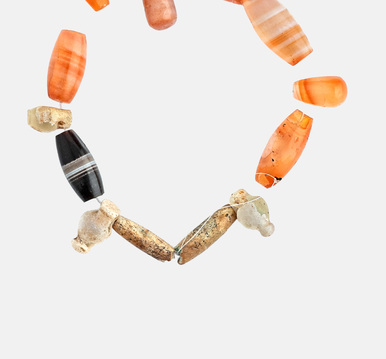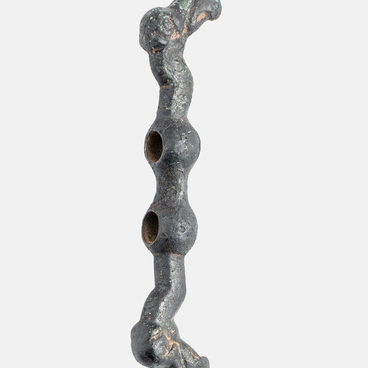The exhibition of the Chelyabinsk State Historical and Archaeological Museum-Reserve “Arkaim” presents a cover for a bronze mirror. The cover was found in the course of the excavations of burial mound 3 of the Marovy Shlyakh burial ground. The burial ground is located 8.5 kilometers south-southeast of the village of Cherkasy, Kizilsky district, Chelyabinsk region, in the interfluve of the Bolshaya Karaganka and Utyaganka rivers, in the upper reaches of the Korytin Dol gully. The burial ground was named after the road Cherkasy — Bredy, which in ancient times was called Marovy Shlyakh. The burial ground consists of five mounds with earth and stone fills. On the largest mound 1 a survey marker was set. Mound 4 with a stone fill was excavated in the 1930s by peasants from the village of Cherkasy. Mounds 2, 3 and 5 were examined in 1992 by an expedition of the Chelyabinsk State University led by Alexander Tairov.
Mound 3 had a diameter of 20.5 meters and a height of 1 meter. The excavated artifacts in the central part of mound 3 included a fragment of a stone altar on three zoomorphic legs, an iron S-shaped cheek-piece, a fragment of iron looped bridles, a bronze cylindrical shaft for cross-belts, a ceramic spindle whorl and a cheek-piece with griffin heads. The cover for the bronze mirror was found in grave pit 5 of mound 3. Grave pit 5 was located north of the center of the mound. At the bottom of the pit in the central part there was the skull of a child of 8–10 years old lying with the eye sockets upwards. The bronze mirror in a leather cover was excavated 25 centimeters southwest of the skull. The cover is sewn from the skin of an animal (steppe polecat), with fur on the inside with edge stitches; the stitches are turned to the back (furless) side. Inside the cover and on the surface of the mirror a large number of mineralized fly pouparia (zoological definition of the archaeozoologist Leonid Leonidvich Gaiduchenko) were preserved.
The bronze mirror with an oval disk has a bluntly
bent edge; the long flat side handle is cast together with the disk. The center
of the disk is damaged, as evidenced by four depressions caused by a
narrow-pointed object of lenticular cross-section. A small flat-bottomed
ceramic vessel was located near the mirror.


